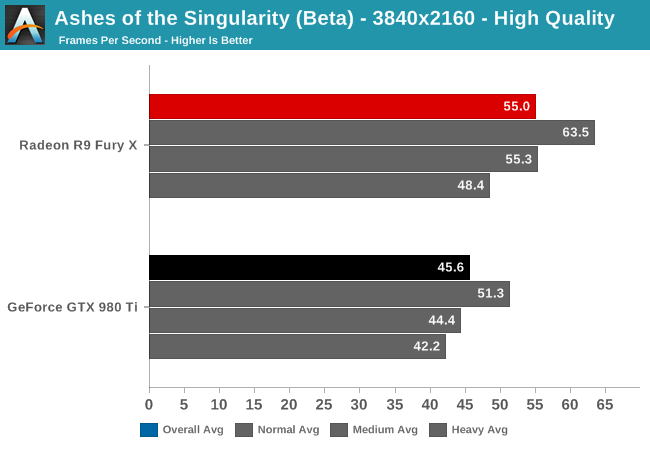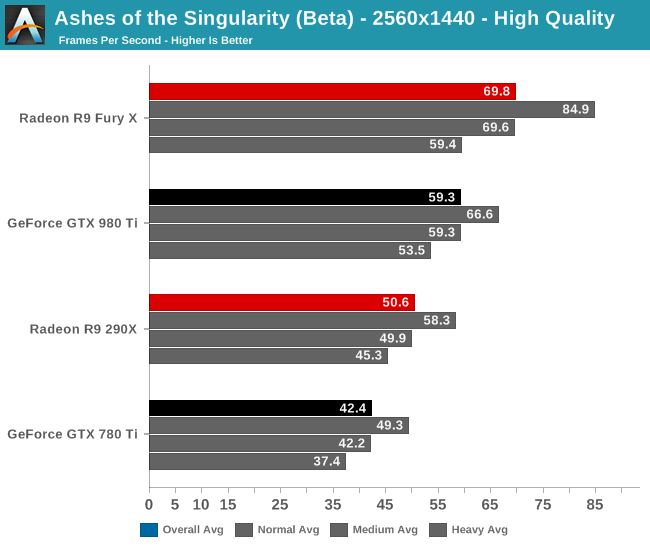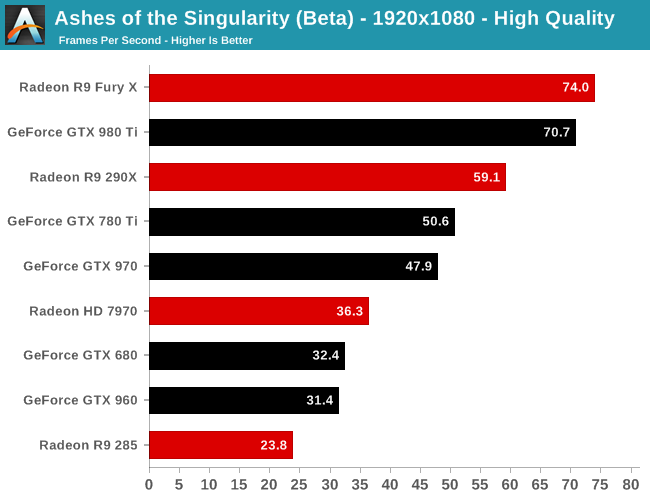Ashes of the Singularity Revisited: A Beta Look at DirectX 12 & Asynchronous Shading
by Daniel Williams & Ryan Smith on February 24, 2016 1:00 PM ESTDirectX 12 Single-GPU Performance
We’ll start things off with a look at single-GPU performance. For this, we’ve grabbed a collection of RTG and NVIDIA GPUs covering the entire DX12 generation, from GCN 1.0 and Kepler to GCN 1.2 and Maxwell. This will give us a good idea of how the game performs both across a wide span of GPU performance levels, and how (if at all) the various GPU generational changes play a role.
Meanwhile unless otherwise noted, we’re using Ashes’ High quality setting, which turns up a number of graphical features and also utilizes 2x MSAA. It’s also worth mentioning that while Ashes does allow async shading to be turned off and on, this option is on by default unless turned off in the game’s INI file.

Starting at 4K, we have the GeForce GTX 980 Ti and Radeon R9 Fury X. On the latest beta the Fury X has a strong lead over the normally faster GTX 980 Ti, beating it by 20% and coming close to hitting 60fps.

When we drop down to 1440p and introduce last-generation’s flagship video cards, the GeForce GTX 780 Ti and Radeon R9 290X, the story is much the same. The Fury X continues to hold a 10fps lead over the GTX 980 Ti, giving it an 18% lead. Similarly, the R9 290X has an 8fps lead over the 780 Ti, translating into a 19% performance lead. This is a significant turnabout from where we normally see these cards, as 780 Ti traditionally holds a lead over the 290X.
Meanwhile looking at the average framerates with different batch count intensities, there admittedly isn’t much remarkable here. All cards take roughly the same performance hit with increasingly larger batch counts.

Finally at 1080p, with our full lineup of cards we can see that RTG’s lead in this latest beta is nearly absolute. The 2012 flagship battle between the 7970 and the GTX 680 puts the 7970 in the lead by 12%, or just shy of 4fps. Elsewhere the GTX 980 Ti does close on the Fury X, but RTG’s current-gen flagship remains in the lead.
The one outlier here is the Radeon R9 285, which is the only 2GB RTG card in our collection. At this point we suspect it’s VRAM limited, but it would require further investigation.










153 Comments
View All Comments
TheJian - Sunday, March 6, 2016 - link
The highlight here isn't dx12, but rather how badly AMD is doing DX11, which is what most games will run on for quite some time to come (only 10% run win10, and much of that base doesn't have a card that can run this game at even 1080P at 30fps). A decent sized group of win10 users go back to win7 also...LOL. I'm more interested in Vulkan, now that it's out, I think it will take over dx12 after a year as it runs everywhere but consoles and they are a totally different animal anyway.This just goes to show what happens when you can't afford to support your products. IE, AMD constantly losing money quarter after quarter while R&D drops too. NV on the other hand, has the cash to massively improve dx11 (which is 90% of the market, more if you consider not everyone running win10 is even a gamer), while also making a dx12 driver. AMD clearly needs to devote more money to their current card users (dx11), but can't afford to. AMD is spending their money on the wrong things time and time again. You can blame consoles for this last 5yrs of losses, as that money should have went into making ZEN 4yrs ago, much faster DX11 support, mobile chips should be on rev 5-6 etc like NV and everyone else etc etc. We would not be looking at NV owning 82%+ of the gpu market right now, and Intel would have had a major competition problem for the last 4-5 yrs instead of basically being able to pour all their resources into mobile while beating AMD to death on cpu.
EugenM - Tuesday, June 7, 2016 - link
I cannot speak of AMD CPUs, but AMD gpus are doing very well on DX11 games, its not the DX11 implementation of AMD that is at fault for performance issues, rather than Nvidia sabotaging time and time again their games, every game which is labeled Nvidia has a potential to sabotage the entire AMD lineup and AMD has little to nothing to do about it, this is not a tin foil conspirancy theory, its a fact proven game after game after game and easelly found on google, try searching for batman games and other epic unreal engine games, try searching for crysis 2 and nvidia gameworks games, youll see what i mean. If youre a small company you cannot really do much about a big monopoly like Nvidia and Intel youre 1 fighting vs 2. Dirty tactics against AMD and even illegal tactics have also been applied by Intel vs AMD, thats why Intel was fined with a huge ammount of money but in the end the damage to AMD was already done and it was too late for AMD to recover properly. You need to realise not everything is so simple.jacksonjacksona - Thursday, March 17, 2016 - link
( www).(ajkobeshoes).(com )christian louboutin
jordan shoes $60-
handbag
AF tank woman
puma slipper woman
=====
( www).(ajkobeshoes).(com )
hhhhhhhh
hhhhhhhh